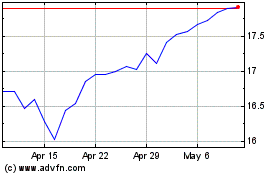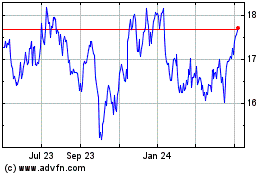PG&E Stock Tanks on Wildfire Liability Concerns
November 14 2018 - 3:29PM
Dow Jones News
By Maria Armental
PG&E Corp.'s stock had its largest single-day plunge since
the early 2000s after the utility said its equipment malfunctioned
last week in an area where California's deadliest wildfire
started.
The disclosure, in a securities filing Tuesday, raised questions
about whether PG&E -- already on the hook for billions of
dollars in damages tied to 2017 fires in the state -- can withstand
potential liabilities from the recent fires. The San Francisco
company said it had $1.4 billion of insurance coverage for
wildfires occurring between Aug. 1, 2018 and July 31, 2019.
If PG&E's equipment is determined to be the cause of the
fire, its liabilities could outstrip its insurance coverage, the
company said in the filing.
PG&E also said it had exhausted its revolving credit
facilities and had roughly a combined $3.5 billion in cash.
Shares recently traded Wednesday at $24.51, down 25% for the day
and on track for their largest percentage decline since 2001,
according to FactSet data. Shares had fallen as much as 46% in
regular trading Wednesday.
PG&E contacted the California Public Utilities Commission to
report a power failure in a Butte County transmission line at 6:15
a.m. Pacific Standard Time on Nov. 8, the day the so-called Camp
Fire was reported.
State records indicate the Camp Fire, which has claimed the
lives of at least 48 people and destroyed 8,817 homes and
businesses, started around 6:30 a.m.
California issued an emergency declaration last week, and
President Trump followed suit on Monday, opening the door for
federal relief funds to potentially flow into affected areas.
On Wednesday, PG&E said it had about 900 workers on site to
help restore service in the Camp Fire-affected area. Where service
can't be restored, the company said, PG&E "is looking at a
longer-term rebuild of the system wherever and whenever customers
rebuild their homes."
"Right now, our primary focus is on the communities and
supporting first responders as they work to contain the fire,"
Chief Executive Geisha Williams said. "We're getting our crews
positioned and ready to respond when we get access, so that we can
safely restore gas and electricity to our customers."
California was hit by an energy crisis in 2000 that sent retail
electricity prices in southern California to record levels, and
generation-capacity shortages forced temporary power outages. State
and federal officials stepped in to ensure that suppliers would
continue selling electricity to California. PG&E's Pacific Gas
& Electric unit went bankrupt in April 2001 after running out
of cash to cover soaring electricity costs. At the time, it
represented the biggest utility bankruptcy in U.S. history.
Write to Maria Armental at maria.armental@wsj.com
(END) Dow Jones Newswires
November 14, 2018 15:14 ET (20:14 GMT)
Copyright (c) 2018 Dow Jones & Company, Inc.
PG&E (NYSE:PCG)
Historical Stock Chart
From Mar 2024 to Apr 2024

PG&E (NYSE:PCG)
Historical Stock Chart
From Apr 2023 to Apr 2024
